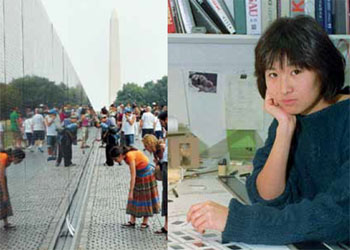国務省出版物
女性実力者の系譜-世界を広げる「マヤ・イン・リン」

(左) ワシントンDCのベトナム戦争戦没者慰霊碑の壁に刻まれた名前を読む訪問者たち(右) マヤ・リン。ニューヨークのオフィスにて
「強く明確なビジョン」
1959年10月5日生まれ
マヤ・リンは、21歳にしてワシントンDCのベトナム戦争戦没者慰霊碑のデザイン・コンテストに優勝し、論争を巻き起こした。彼女は今でも、退役軍人のグループが彼女のデザインを「恥辱の黒い傷」と呼んで非難したときに感じた怒りと苦痛を憶えているという。しかし、当初のそうした批判は、もはや重要ではない。当時エール大学建築学部の学生だったリンの設計した慰霊碑は、米国で最も多くの人たちが訪れる、人気の高い記念碑となり、今では建築の傑作として認められている。何十万もの人たちが、このV字型の黒い御影石の壁に彫られた戦死者・行方不明兵士の名前を読み、触って、感動し慰められている。そうした人たちと、彼らが残していく記念品を見れば、「この記念碑は亡くなった人たちのためのものであり、私たちにとっては追憶のためのものなのです」というリンの目標が達成されているということに、誰もが同意するはずである。
リンは、オハイオ州アセンズで、中国から移民としてやってきた両親の下に生まれた。最初の著名なプロジェクトとなったベトナム戦争戦没者慰霊碑のほかにも、建築家と彫刻家としての技能を組み合わせた重要な作品を数多く設計している。アラバマ州モンゴメリーの公民権運動記念碑は、壁と平たい円盤から成り、その上を水が流れているもので、彼女はこれを、マーティン・ルーサー・キング・ジュニアの「私には夢がある」というスピーチからインスピレーションを得て設計したという。水を中心的な存在として使ったのは、「われわれは正義が水のように流れ落ち、公正が力強い流れのようになるまで満足することはない」というキングの言葉による。彼女のその他の作品には、テネシー州クリントンのラングストン・ヒューズ図書館、ニューヨーク市のアフリカ芸術美術館、ノール社の「The Earth Is (Not) Flat」というシリーズの家具、そしてエール大学にある記念碑「女性のテーブル」などがある。
リンは、米国芸術・文学アカデミーの賞、大統領デザイン賞、米国建築家協会名誉賞を受賞しているほか、ハーバード、エール、ブラウン、スミス、ウィリアムズの各大学から名誉美術博士号を授与されている。2003年には、世界貿易センター跡地記念碑のデザイン・コンペの審査員を務めた。また2005年には、ニューヨークの全米女性の殿堂に入っている。リンの人生のドキュメンタリー映画「マヤ・リン―強く明確なビジョン」のタイトルは、彼女が記念碑のデザインのプロセスについて語ったスピーチから取ったものである。
リンはインタビューで、彼女の創作に影響を与えたのは、ホープウェル・インディアンの古墳、日本の掃きならされた砂の庭、そして1960年代・70年代の米国のアースワークの芸術家であると語っている。環境問題に関心の深い彼女は、作品の多くに、リサイクルした材料、生きた材料、そして天然の材料を使っている。
*上記の日本語文書は参考のための仮翻訳で、正文は英文です。
Maya Ying Lin - Women of Influence
“A Strong, Clear Vision,” a speech by Lin on the monument design
(Born: October 5, 1959)
Maya Lin became a controversial figure at the age of 21, when she won first prize in the design competition for a Vietnam Veterans Memorial in Washington, D.C. She still remembers her anger and bitterness when a group of veterans denounced her design as "a black gash of shame." That initial criticism, however, no longer matters. The memorial by the then Yale University architecture student has become the most-visited and beloved monument in the United States and an acknowledged architectural masterpiece. Hundreds of thousands of visitors have been moved and comforted as they read and touched the names of the dead and missing inscribed on its V-shaped black granite wall. Seeing the visitors, and the mementos they leave behind near the names of their loved ones, any observer would agree that Lin succeeded in her goal: "This memorial is for those who have died, and for us to remember."
Since that first famous project, Lin – born in Athens, Ohio, of Chinese immigrant parents – has designed many other significant works that often combine her skills as an architect and a sculptor. Her Civil Rights Memorial in Montgomery, Alabama, in the form of a wall and flat disk over which water flows, was inspired by Martin Luther King Jr.'s "I have a dream" speech. Lin used water as its principal feature, drawing on King's words: "We are not satisfied and we will not be satisfied until justice rolls down like waters and righteousness like a mighty stream." The Langston Hughes Library in Clinton, Tennessee; the Museum for African Art in New York City; a line of furniture for the Knoll company called "The Earth Is (Not) Flat"; and another memorial, The Women's Table at Yale University, are some of her other works.
She has won the architecture prize from the American Academy of Arts and Letters, the Presidential Design Award, and the American Institute of Architects Honor Award, as well as honorary doctorates in Fine Arts from Harvard, Yale, Brown, Smith, and Williams. In 2003, she was one of the selection jurors for the World Trade Center Site Memorial competition. In 2005, Lin was elected to the National Women's Hall of Fame in New York. An award-winning documentary about her life, Maya Lin: A Strong, Clear Vision, took its title from a speech she gave about the monument design process.
In interviews, Lin has said that the Hopewell Indian earthen mounds, Japanese raked-sand gardens, and the American earthworks artists of the 1960s and '70s have influenced her creations. She always works with the landscape. Concerned about the environment, she uses recycled, living, and natural materials in many of her works.
For additional information, see:
Lin, Maya. Architecture and Sculpture
http://www.artcyclopedia.com/artists/lin_maya.html
Lin, Maya. Vietnam Veterans Memorial
http://www.greatbuildings.com/buildings/Vietnam_Veterans_Memorial.html




